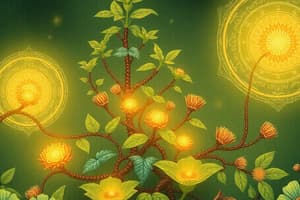Podcast
Questions and Answers
Which of the following is NOT an example of a primary metabolite?
Which of the following is NOT an example of a primary metabolite?
- L-glutamate
- Lactic acid
- Erythromycin (correct)
- Ethanol
Primary metabolites are essential for growth, development, and reproduction.
Primary metabolites are essential for growth, development, and reproduction.
True (A)
What is the primary role of secondary metabolites in organisms?
What is the primary role of secondary metabolites in organisms?
Ecological functions such as defense mechanisms.
Citric acid is commonly produced by _____________.
Citric acid is commonly produced by _____________.
Which of the following molecules is classified as a secondary metabolite?
Which of the following molecules is classified as a secondary metabolite?
Match the following metabolites with their categories:
Match the following metabolites with their categories:
_________ are known for their role in large-scale production in industrial microbiology.
_________ are known for their role in large-scale production in industrial microbiology.
Secondary metabolites are produced mainly during the growth phase of an organism.
Secondary metabolites are produced mainly during the growth phase of an organism.
Which antibiotic is derived from Saccharopolyspora erythraea?
Which antibiotic is derived from Saccharopolyspora erythraea?
Bacitracin is mainly used as an oral antibiotic.
Bacitracin is mainly used as an oral antibiotic.
What is the primary purpose of photosynthesis?
What is the primary purpose of photosynthesis?
Photosynthesis takes place in the ______.
Photosynthesis takes place in the ______.
Match the following components with their roles in photosynthesis:
Match the following components with their roles in photosynthesis:
What is released as a waste product during photosynthesis?
What is released as a waste product during photosynthesis?
Glucose is stored in plants primarily in their leaves.
Glucose is stored in plants primarily in their leaves.
What process uses light energy captured by chlorophyll?
What process uses light energy captured by chlorophyll?
The equation for photosynthesis can be summarized as: 6CO2 + 12 H2O + light energy -> C6H12O6 + 6O2 + ______.
The equation for photosynthesis can be summarized as: 6CO2 + 12 H2O + light energy -> C6H12O6 + 6O2 + ______.
Which of the following pigments mainly absorbs light during photosynthesis?
Which of the following pigments mainly absorbs light during photosynthesis?
Where does the light-dependent reaction of photosynthesis take place?
Where does the light-dependent reaction of photosynthesis take place?
The dark reaction of photosynthesis requires sunlight to occur.
The dark reaction of photosynthesis requires sunlight to occur.
What are the two types of photosystems involved in the light reactions?
What are the two types of photosystems involved in the light reactions?
Match the following processes or terms with their descriptions:
Match the following processes or terms with their descriptions:
During the light reactions, light energy is converted to ______ and ______.
During the light reactions, light energy is converted to ______ and ______.
Which of the following is a product of the light-dependent reactions?
Which of the following is a product of the light-dependent reactions?
Oxygen is produced during the dark reactions of photosynthesis.
Oxygen is produced during the dark reactions of photosynthesis.
What is the main purpose of the Calvin cycle?
What is the main purpose of the Calvin cycle?
The chemical equation for the light reaction of photosynthesis can be summarized as: 2H2O + 2NADP+ + 3ADP + 3Pi → ______ + 2NADPH + 3ATP.
The chemical equation for the light reaction of photosynthesis can be summarized as: 2H2O + 2NADP+ + 3ADP + 3Pi → ______ + 2NADPH + 3ATP.
Which molecule is primarily used during the Calvin cycle to drive the reactions?
Which molecule is primarily used during the Calvin cycle to drive the reactions?
Which amino acids are produced by the shikimate pathway?
Which amino acids are produced by the shikimate pathway?
Malonate is formed from acetyl-CoA by the removal of CO2.
Malonate is formed from acetyl-CoA by the removal of CO2.
What is the primary function of the mevalonate pathway?
What is the primary function of the mevalonate pathway?
The shikimate pathway connects __________ and specialized metabolism in the plant cell.
The shikimate pathway connects __________ and specialized metabolism in the plant cell.
Match the following terms with their descriptions:
Match the following terms with their descriptions:
Which carbon units are derived from acetyl-CoA?
Which carbon units are derived from acetyl-CoA?
The shikimic acid pathway is utilized only by plants.
The shikimic acid pathway is utilized only by plants.
What are the two substrates that start the shikimic acid pathway?
What are the two substrates that start the shikimic acid pathway?
The shikimate pathway is also known as the ______ pathway.
The shikimate pathway is also known as the ______ pathway.
Match the following enzymes with their functions in the shikimate pathway:
Match the following enzymes with their functions in the shikimate pathway:
Which aromatic amino acids are synthesized through the shikimate pathway?
Which aromatic amino acids are synthesized through the shikimate pathway?
The shikimic acid pathway involves seven enzymatic steps.
The shikimic acid pathway involves seven enzymatic steps.
What environmental stresses can trigger the expression of phenolic compounds?
What environmental stresses can trigger the expression of phenolic compounds?
Chorismate is a substrate for the three aromatic amino acids: ______, ______, and ______.
Chorismate is a substrate for the three aromatic amino acids: ______, ______, and ______.
The basic process for the biosynthesis of phenolic compounds occurs in:
The basic process for the biosynthesis of phenolic compounds occurs in:
Flashcards are hidden until you start studying
Study Notes
Metabolism
- Metabolism refers to all chemical reactions within living organisms, essential for life.
- Metabolites are the products or intermediates of these processes.
Primary Metabolites
- Directly involved in normal growth, development, and reproduction.
- Perform an intrinsic physiological function within an organism.
- Formed during the growth phase.
- Examples include ethanol, lactic acid, and certain amino acids.
Secondary Metabolites
- Typically formed during the stationary phase of growth.
- Not directly involved in growth, development, or reproduction.
- Often play a role in ecological function, like defense mechanisms.
- Examples include atropine, erythromycin, and bacitracin.
Photosynthesis
- Captures light energy and converts it into simple sugars.
- Occurs in chloroplasts of green organisms.
- Equation: 6CO2 + 12H2O + light energy -> C6H12O6 + 6O2 + 6H2O
Photosynthesis Steps
- Carbon dioxide enters through stomata; water absorbed by roots and transported to leaves through xylem.
- Chlorophyll absorbs light energy to split water molecules into hydrogen and oxygen.
- Hydrogen and carbon dioxide combine to produce glucose; oxygen is released as a waste product.
- Glucose provides energy for growth and development; excess stored in roots, leaves, and fruits.
- Pigments: Molecules that absorb light at specific wavelengths and reflect unabsorbed light.
- Chlorophyll a, chlorophyll b, and carotenoids are major pigments present in thylakoids of chloroplasts.
Light-Dependent Reaction
- Occurs during the day in the presence of sunlight.
- Takes place in the thylakoid membranes of chloroplasts.
- Grana: Membrane-bound sacs in thylakoid that gather light; called photosystems.
- Photosystems: Complexes of pigments and proteins that capture light energy.
- Two main types: Photosystem I and Photosystem II.
- Converts light energy into ATP and NADPH for the next stage of photosynthesis.
- Equation: 2H2O + 2NADP+ + 3ADP + 3Pi → O2 + 2NADPH + 3ATP
Light-Independent Reaction (Dark Reaction)
- Also known as the carbon-fixing reaction.
- Light-independent process where sugar molecules are formed from water and carbon dioxide.
- Occurs in the stroma of the chloroplast.
- Uses NADPH and ATP produced during the light reaction.
- Plants capture carbon dioxide through stomata and proceed to the Calvin cycle.
- The Calvin cycle uses ATP and NADPH to convert 6 carbon dioxide molecules into one glucose molecule.
- Equation: 3CO2 + 6 NADPH + 5H2O + 9ATP → G3P + 2H+ + 6 NADP+ + 9 ADP + 8 Pi
- G3P: Glyceraldehyde-3-phosphate
Calvin Cycle Reactions
- Divided into three main stages:
- Carbon fixation: Incorporates carbon dioxide into an organic molecule.
- Reduction: Uses ATP and NADPH to convert carbon dioxide into sugar.
- Regeneration: Regenerates the starting molecule to continue the cycle.
Building Blocks of Secondary Metabolites
- C1: Derived from the S-methyl group of L-methionine.
- C2: Derived from acetyl-CoA.
- C5: Derived from isoprene units.
- C6-C3: Derived from phenylalanine or tyrosine through the shikimic acid pathway.
Basic Metabolic Pathways for Secondary Metabolite Production
- Shikimic acid pathway: Biosynthesis of phenolic compounds, alkaloids, and others.
- Occurs in chloroplast plant cells and utilizes phenylpropanoid precursors.
- Triggered by environmental stresses like pathogens, herbivores, UV radiation, etc.
- Produces aromatic amino acids (phenylalanine, tyrosine, and tryptophan).
- Starts with phosphoenol pyruvate and erythrose-4-phosphate, ends with chorismate.
- Malonic-acid pathway (Malonate/Acetate): Involves acyl carrier protein (ACP) to yield fatty acylthioesters of ACP.
- These thioesters form intermediates in fatty acid synthesis.
- C2 acetyl CoA units produce fatty acids from butyric to arachidic acid.
- Mevalonic-acid pathway (Mevalonate): Also known as the isoprenoid pathway.
- Involves synthesis of 3-hydroxy-3- methylglutaryl-CoA reductase (HMGCR).
- Key pathway for cholesterol biosynthesis and other cellular processes.
- Produces isopentenyl pyrophosphate (IPP) and dimethylallyl pyrophosphate (DMAPP), which are building blocks for isoprenoids.
Studying That Suits You
Use AI to generate personalized quizzes and flashcards to suit your learning preferences.




